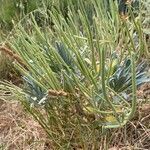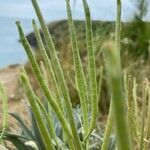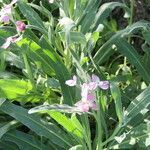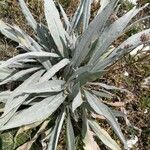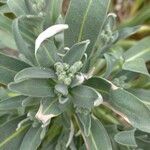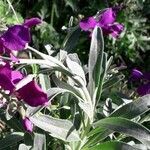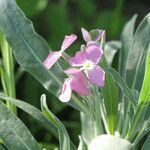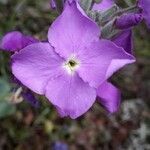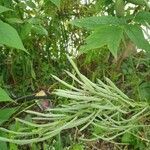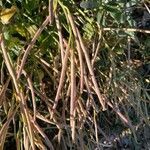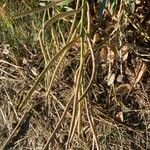A cabbage family herb. It is a robust plant which keeps growing from year to year. It grows 50 cm high and spreads 30 cm wide. It is woody at the base. The leaf scars are easy to see. The leaves are crowded near the ends of the branches. The lower leaves have leaf stalks but the upper leaves do not. The leaf blade is narrow and sword shaped. It is 3-12 cm long and entire. It has dense hairs over it. The flowers have a sweet scent. The sepals are narrow and 9-13 mm long. They are densely hairy outside. The petals are oval and 2.5 cm long. They are pink, mauve or white. The fruit have lobes 2-3 mm long. The pods are narrow and flattened. They are 4.5-13 cm long. The seeds are 3 mm long.
Perennial. Stems hairy, branched, stout, erect, woody, to 80 cm tall, bearing conspicuous lf base scars below. Lvs tufted at branch tips, lanceolate, obtuse, entire, sinuate or shallowly pinnatifid, densely tomentose, glaucous, cuneate at base, (3)-8-15-(30) × (0.5)-1-2-(4) cm. Racemes 15-20-(30) cm long; pedicels erecto-patent, 1-2 cm long. Fls fragrant, opening by day. Sepals densely hairy, 9-13 × 1.5-2.5 mm. Petals pink to purple, 18-25 × 5-10 mm. Silique flattened, 50-120 × 3-5 mm; stigma lobes 1.5-2 mm long, dorsally swollen but not horned; valves densely hairy. Seeds circular, brown, flattened, broadly winged, 2-3 mm diam.
Perennial herb 10–80 cm tall, stout, woody at base, densely tomentose; hairs stellate and glandular. Leaves linear-lanceolate, entire, rarely sinuate-pinnatifid; lower leaves petiolate; upper leaves subsessile. Sepals 9–13 mm long. Petals 20–30 mm long, purple, pink or white. Stigmatic lobes with inconspicuous dorsal processes to 3 mm long. Siliqua linear, 45–160 mm long, 3–5 mm wide; valves compressed with one prominent midvein, tomentose; glandular hairs absent; pedicels erect to spreading, 1–2.5 mm long. Seeds ovate, 2.5–3 mm long, compressed, winged.
